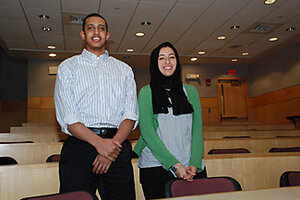A bid to enroll Arabs in U.S. colleges
MIT students help dispel their fears and doubts about applying to American schools, where they remain a relative minority after 9/11.

Mentors: MIT students Hassen Abdu and Iman Kandil help Arab students come to US universities.
Tom A. Peter
Cambridge, Mass.
Like any good high school student, Lana Awad dreamed of an Ivy League education. But when the Syrian teen started applying to Massachusetts Institute of Technology, Princeton University, and Harvard College, her guidance counselor told her to think smaller. After all, no one from her high school in Riyadh, Saudi Arabia had ever gone to a college farther away than Lebanon, just across the Arabian Peninsula.
"They wanted me not to be disappointed, not to feel, you know, rejected ... advising me not to aim too high," says Ms. Awad. In the end, she got into Princeton and MIT, where she is now a freshman.
At a time when Arab enrollments in US universities are still recovering from a post-9/11 plunge, it is experiences like Awad's that an MIT student group is trying to change. The College Admissions Arab Mentorship Program (CAAMP), whose members have just returned from their annual tour of Middle Eastern schools, aims to ensure that myths about American colleges and life in the US don't deter Arabs from studying here. The group encourages Middle Eastern students to take advantage of US universities so they can become more effective leaders in their homeland, as well as agents of cross-cultural exchange.
During its tours, the group tells Arab teens they have the opportunity to take their culture to the States, "to teach people about [themselves], and where [they're] coming from, and, at the same time, to learn from people in the States. So it's a two way street," says Ibrahim Kanan, an MIT senior engineering major and CAAMP member.
Still, in a post-9/11 landscape, conveying this message to students in countries like Libya or the West Bank is challenging, especially as tighter US visa restrictions have discouraged many from applying, says Iman Kandil, CAAMP's co-founder and an MIT junior.
Though the number of all international students declined steadily from 2001 until last year – when it began an uptick again – the number of students from the Middle East (excluding Israel) and North Africa still constitutes less than 4 percent of international students in the US. That's a drop of nearly half compared with the 2000-01 academic year just before the 9/11 attacks, when Arabs were 7 percent of international students.
Meanwhile, students from India, China, South Korea, and Japan alone totaled 43 percent of international students last year.
Young Arabs worry they won't get a visa, but many also think their educations won't meet US standards, says Ms. Kandil. "The average student in Egypt, for example, thinks it's impossible for a student with an Egyptian diploma to get admitted [to a US university]," says Kandil, an Egyptian-American who was disappointed by the small number of Arabs at MIT – about 3 percent of international students there.
Others worry that as Arabs and/or Muslims, they will meet discrimination in the US. One student in the West Bank asked if a Palestinian passport would immediately disqualify him from American schools.
"We tell them generally, especially on college campuses, people are liberal and open-minded," says Kandil, who wears a traditional Muslim head scarf. "You get stares sometimes, you get curious questions ... you get an occasional dirty look. We don't lie to them; we tell them exactly what we experience."
Rather than a liability, ethnicity can be a great asset, CAAMP members tell prospective Middle Eastern students. "Our goal [is] to make them realize they're coming from unique backgrounds and they can leverage that for their benefit in applying for colleges," says Mr. Kanan, himself a Palestinian-American.
Kandil and her friend Hassen Abdu created CAAMP in 2006 as an MIT recruitment program, but it has morphed into a general drive to encourage Arabs to apply to American colleges. Group members visited 700 teens last year and more than 3,500 high school students this winter in Egypt, Libya, Morocco, Tunisia, Saudi Arabia, Lebanon, Syria, and Palestine.
Private donors interested in education and improving US-Arab relations, as well as the MIT Arab Alumni Association and Saudi ARAMCO, fund CAAMP's trips.
Whatever their ethnicity, talented minority students, says Mr. Abdu, an Eritrean, are often unaware of educational opportunities and don't understand how to navigate the application process from overseas. Matters are also complicated by an industry of con men claiming to guarantee admission for enormous fees.
Most Arab students also don't realize the importance American colleges place on extracurricular activities, since admissions criteria in the Middle East or even Europe, admissions criteria focus largely on grades and exam scores.
Kandil recounts meeting two Lebanese applicants to MIT. "We found out ... that they had built a go-cart from scratch. And not only that, they had it run on crushed bananas and they did not include that in their application. We freaked out," says Kandil, who urged them to send a supplement to the admissions board about their banana-powered cart.
"International students have the same questions [as American students], and they need authentic voices," says Dr. Allan Goodman, president of the Institute of International Education, headquartered in New York City .Spreading word about American education is key, he says. He says that "I don't think we can depend on people knowing that the US is here [for higher education] any more."
